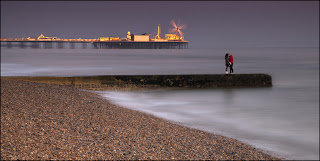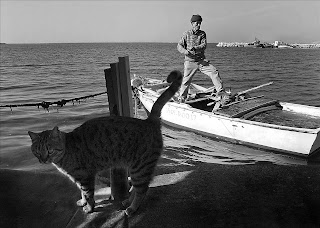Documentary Photography
Thursday, 17 May 2012
Photoessay
In addition to printing off my photos I also put them into a moving photo essay inspired by the Magnum in Motion Series
Saturday, 5 May 2012
Patterns, Architecture and Examples
While
shooting for my first project I encountered an issue regarding the direction
and narrative possessed by my photos; after a few nights in the town I realised
I had an erratic array of images that didn’t really point to my concept or tell
any sort of narrative, at the end of each shoot all I had was a collection of
photos of the city, at night and not specifically an eerie, mysterious city I
wanted to portray.
Therefore I have decided to look into patterns and architecture at night after being inspired by the cover of Brassai's book, 'Paris De Nuit'
G.E. Kidder Smith
Therefore I have decided to look into patterns and architecture at night after being inspired by the cover of Brassai's book, 'Paris De Nuit'
I have found some photographers who specialize in architecture photography as well as pattern photography
G.E. Kidder Smith
Friday, 4 May 2012
Minor Project - Establishing Shot
The shot below will be my Establishing shot.
This image was chosen as it successfully sums up everything I am to be shooting for this project. Firstly your eyes are drawn to the reflecting light on the right hand barrier which then draws your eyes towards the centre of the image where you see a faint blur of movement, a person. The bridge then cuts the image in half which leads your eyes away from the centre, and back down to the foreground where the strong shadows are cast by the fences.
This image contains the main elements I aim to shoot for my main project, the strong bold shadows, reflecting light, enticing shapes created by architecture and the pale yellowy colours cast by streetlights amplified by the dim night sky and finally the contrasting lighting of night, for example in the top right there is a strong white light yet the rest of the image is lit up by a yellowy cast caused by a streetlamp
Saturday, 28 April 2012
Research into photographers
As mentioned previously, for my main project I intend to explore Worcester by Night, making use of available light to create dynamic and enticing images. The photographers below show some examples that I can draw inspiration from.
Brassai - Paris By Night
"While his images reflect the glitter and gaiety the city was famous for. He also chronicled the city’s nocturnal workers: night-beat policemen, their capes billowing over their bicycles; workmen polishing tram tracks; a milkman loading milk cans onto his horse-drawn cart."
A few examples of his work are in the video below
Bill Schwab - Bill Schwab is a clear follower in Brassai’s footsteps, using a similar interplay of artificial light and fog in much of his work. But Schwab’s work does not feature the light in the foreground, as Brassai’s did, but piercing through the subject of the photo from the background. This effect gives Schwab’s subjects a sort of hollow, lifeless quality that he manipulates to great effect, especially when focusing on symbols of his native Michigan’s suffering economy.
Robert Brook works with more Urban subjects which provides a more modernistic look for his images in comparison to the above (Brassai 1933, Schwab 1994+)
Friday, 27 April 2012
Minor Project - Shotscript
Working title
When the sun goes
down…
City Nights
City Nights
Worcester by Night
Treatment – Photography is an art form wholly built on the
availability of light but what happens when we lose the main source of light
that lights up the World after the sun goes down?
Well we gain thousands of individual points of
artificial light of every different colour and tonal quality. Colours become
muted, shadows become deeper, and that boring car parked on the side of the
road during daytime is transformed into a gleaming chariot of reflected light amongst
the darkness.
The outline of the story – To show images that demonstrate the unique
light that comes about at night, muted colours, contrasting greys and deep/dark
shadows and how these transform everyday objects at night into something
different.
Options for an establishing shot
·
Cityscape at night, with numerous sources of light
casting dark shadows
·
Any strong reflections of light
·
Architecture lit up at night (contrasting
textures and unusual shadows) for example the various structures in Worcester,
the Hive, Friar Street and the main bridges (Road Bridge, Train Bridge and
Sabrina Bridge)
Pre-visualisation –
Architecture:
- Worcester Train Bridge: Focus
on shape of bridge, taking into account the semi-circles and
contrasting straight lines - Tripod Low ISO,
slow shutter speed, wide angle (around 24mm), F5/0 (fastest
setting for particular lens)
- The Hive: Focus on lines and
shapes created by the roofing/lights, also showing the gold plating
- Tripod, Low ISO, very slow shutter speed, wide angle
(around 24mm), F10 (slowest setting for particular lens , for depth of
field)
- Worcester Cathedral: Shoot
down one side of the cathedral rather than straight on, focusing on the
contrasting architecture, lighting, and shadowy trees. Tripod,
Low ISO, very slow shutter speed, wide angle (around 24mm),
F10 (slow for particular lens , for depth of field)
Street
- Shop windows: Capture
reflections of light/street - High ISO, medium-slow
shutter speed, F2/8
- Streetlights: Shadows cast, luminance
and atmosphere created by lights - High
ISO, medium-slow shutter speed, F2/8
- Parked Cars: Reflection of surrounding area
and light - High ISO, medium-slow shutter speed, F2/8
Cityscapes
- Over
city centre: City lights, shadows, movement - Tripod, Low ISO, slow shutter speed, F8
or slower
Equipment list – DSLR, sturdy tripod, weatherproof bag,
remote shutter release, a fast lens (50mm f1/8+), kit lens (18mm-50mm f3/5-f5/6),
lens hood, flashlight just in case
Legal matters – No legal matters should come to fruition
but may need to permission to enter buildings in order to gain a unique
perspective (I.e. top floor of buildings)
Special arrangements – Will be carried out over a 3 or 4 separate
nights over the space of 2 weeks
Weather watch – Various environments indoor and out, rain
although bad for the equipment would bring about even more unique photos
Specialised equipment/clothing needed – Waterproof coat
Monday, 12 March 2012
The Golden Age
The Great Depression in 1930 brought about a larger influx of Documentary Photography
Magazines such as Life, Picture Post and Paris Match brought about a large fan base through the use of photographs.
I decided to look into a single prominent photographer from this era instead of collecting images from a number, I decided to do this purely on the fact that it'd help me identify their particular style of photography and find out any pattens.
Magazines such as Life, Picture Post and Paris Match brought about a large fan base through the use of photographs.
I decided to look into a single prominent photographer from this era instead of collecting images from a number, I decided to do this purely on the fact that it'd help me identify their particular style of photography and find out any pattens.
"Photographs can summon enough emotion to be a catalyst to thought." - W. Eugene Smith
Monday, 20 February 2012
Task 2 Cropping the image
Task 2 required us to crop an image to change the perceived meaning of the photo
I used various online sources to find photos including Flickr and the photo.net galleries
 The first image shows a couple kissing at the edge of a mini pier(?) captured with a slow shutter speed which has left light trails of the fair ground in the background as well as motion blurring from the waves crashing as if for that one moment, time slowed down for this couple
The first image shows a couple kissing at the edge of a mini pier(?) captured with a slow shutter speed which has left light trails of the fair ground in the background as well as motion blurring from the waves crashing as if for that one moment, time slowed down for this couple
My first crop of that image took the couple right out of the image so now it is only the pier and fairground you can see
 My second image taken from the photo.net galleries show a cat waiting for a fishing boat to return for an easy meal
My second image taken from the photo.net galleries show a cat waiting for a fishing boat to return for an easy meal
I first cropped it so now it is just an average view out towards the sea, this completely removes the original story behind this image and could easily of been taken by anybody standing on a beach or dock
The second image just shows the cat standing on the edge of a platform surrounded by water which conflicts with the general assumption that cats are scared of water.
I used various online sources to find photos including Flickr and the photo.net galleries
 The first image shows a couple kissing at the edge of a mini pier(?) captured with a slow shutter speed which has left light trails of the fair ground in the background as well as motion blurring from the waves crashing as if for that one moment, time slowed down for this couple
The first image shows a couple kissing at the edge of a mini pier(?) captured with a slow shutter speed which has left light trails of the fair ground in the background as well as motion blurring from the waves crashing as if for that one moment, time slowed down for this coupleMy first crop of that image took the couple right out of the image so now it is only the pier and fairground you can see
.
And my final crop focused on just the couple kissing so it is not apparent where they are
 My second image taken from the photo.net galleries show a cat waiting for a fishing boat to return for an easy meal
My second image taken from the photo.net galleries show a cat waiting for a fishing boat to return for an easy mealI first cropped it so now it is just an average view out towards the sea, this completely removes the original story behind this image and could easily of been taken by anybody standing on a beach or dock
The second image just shows the cat standing on the edge of a platform surrounded by water which conflicts with the general assumption that cats are scared of water.
Subscribe to:
Comments (Atom)




















